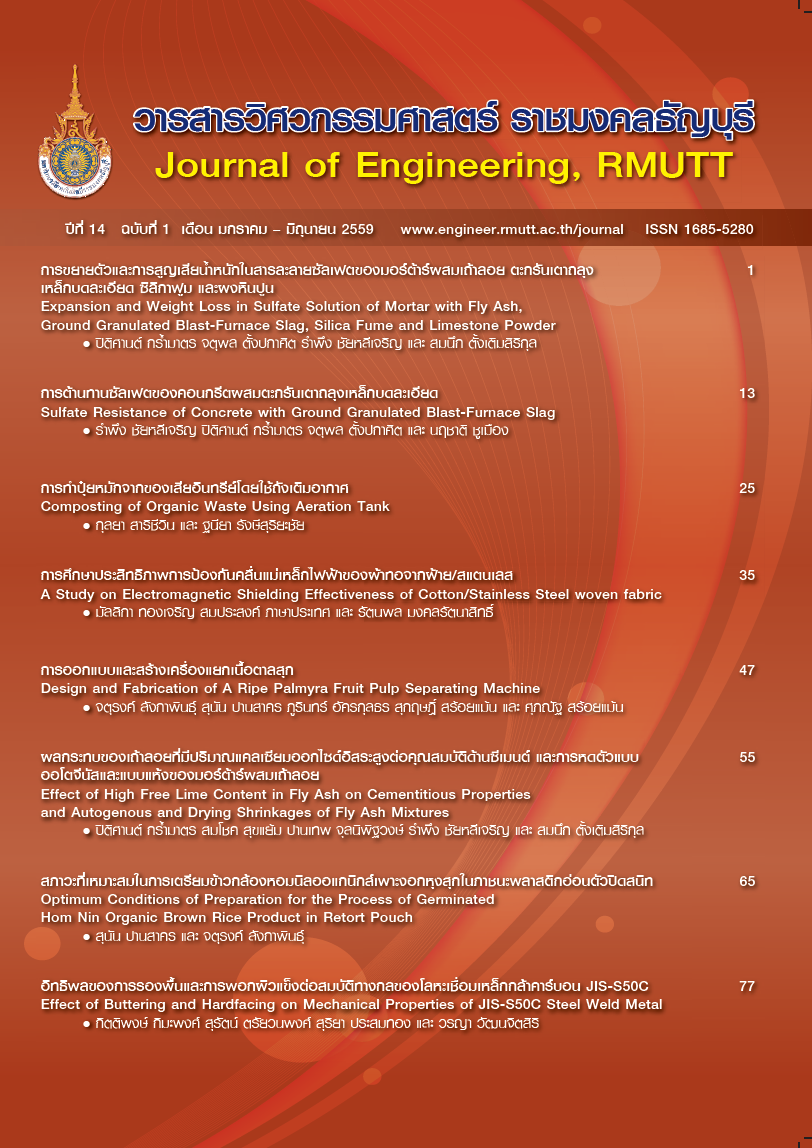Expansion and Weight Loss in Sulfate Solution of Mortar with Fly Ash, Ground Granulated Blast-Furnace Slag, Silica Fume and Limestone Powder
Main Article Content
Abstract
This research aims to study the expansion in sodium sulfate solution and weight loss in magnesium sulfate solution of mortar with fly ash, ground granulated blast-furnace slag (GGBS), silica fume and limestone powder which are industrial wastes. These industrial wastes were used to partially replace in Portland cement type 1 (OPC). The study found that in sodium sulfate solution, expansion of mortars with fly ash, GGBS, silica fume and limestone powder was less than all of the OPC mortars. Except when replaced with limestone powder and with fly ash or GGBS at small quantities, the expansion will be higher than or close to all of the OPC mortars. Besides, in magnesium sulfate solution, weight loss of mortar with GGBS and fly ash was greater than all of the OPC mortars. While the weight loss of mortar with silica fume was no different from all of the OPC mortars. Finally, the replacement of limestone powder in OPC mortars tend to be lesser weight loss than OPC mortars, except when replaced with limestone powder at large amount of fly ash and / or GGBS.
Article Details
The manuscript, information, content, picture and so forth which were published on Frontiers in engineering innovation research has been a copyright of this journal only. There is not allow anyone or any organize to duplicate all content or some document for unethical publication.
References
Tangtermsirikul S. and Bumrungwong C, Conceptual Model for Determining Optimum Proportion of Fly Ash in Sulfate resisting Concrete,Proceedings of the 3rd National Convention on Civil Engineering, Thailand, January, 1997,pp. MAT 4-1 to 4-9.
Songpiriyakij S. and Jaturapitakkul C., A Study of Ground Mae Moh Fly Ash as a Pozzolan for Increasing Concrete Strength, KMITT Research and Development Journal, Vol. 18, No. 2. pp.52-64, 1995.
Kaittikomol K., Jaturapitakkul C., siripanichgorn A., Nimityongskul P., Chindaprasirt P. and
Tangsathitkulchai C., Influence f Fineness of Classified Fly Ash on Compressive Strength
and Sulfuric Acid Attack of Mortar,Proceedings of the 3rd National Convention on
Civil Engineering, Thailand, January, 1997,pp. MAT 2-1 to 2-10.
Chindaprasirt P., Meatanan S., Mangmeesri S., and Sinsiri T., Properties of Compacted Concrete Containing Fly Ash and Black Rice Husk Ash,Proceedings of the 6th National Convention on Civil Engineering, Thailand, January, 2000, pp. MAT- 47 to -57.
Al-Amoudi, O. S. B., Mechanisms of Sulfate Attack in Plain and Blended Cement: a
Review, Proceeding of the International Seminar, September 1999, University of Dundee, Scotland, UK, pp. 247-260.
Pitisan Krammart, “Properties of cement made by partially replacing cement raw materials with municipal solid waste ash and calcium carbide waste, and sulfate resistance of flyash concrete”, Ph. D. Thesis, Civil Engineering, School of Civil Engineering and Technology, Sirindhorn International Institute of Technology Thammasat University, 2005.
Ittiporn S., Lalita B., Warangka S., Pitisan K., and Somnuk T. “Sodium and Magnesium Sulfate Resistance of Mortars with Interground Limestone and Limestone Powder Replacing
Cements,” Journal of Advanced Concrete Technology, volume 12 (2014), pp. 403-412.


